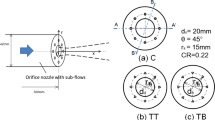Abstract
The effect of the exit geometry of a vortex ring generator was studied experimentally. Two types of exit geometries were chosen: an orifice and a nozzle. Vortex rings were generated by pushing a solenoid-valve-controlled, pressurized-air jet through the circular opening of the orifice or nozzle. Experiments were performed over a wide range of initial Reynolds number (450≤Re≤4580) and length-to-diameter ratio (0.7≤L/D≤7.0) of the air jet. The exit geometry was found to significantly influence the entire course of propagation of the vortex ring. The orifice-generated vortex ring had superior characteristics to that produced by the nozzle under the same conditions. The vorticity generated along the wall in the orifice exit plane had a negligible effect on the circulation of the vortex ring within the specified range of Reynolds number. Compared to the nozzle-generated vortex ring, the orifice-generated ring showed reduced initial vorticity losses and less diffusive entrainment of ambient fluid. The vortex rings produced by the orifice attained more circulation, less entrainment of ambient fluid and hence rapidly propagated through longer distances in comparison to the nozzle-generated rings.
Similar content being viewed by others
References
Allen, J.J. and Auvity, B., Interaction of a Vortex Ring with a Piston Vortex, J. Fluid Mech. 465 (2002), 353–378.
Arakeri, J.H., Das, D. and Lourenco, L., Vortex Ring Formation at the Open End of a Shock Tube: A Particle Image Velocimetry Study, Phys. Fluids 16 (2004), 1108–1019.
Auerbach, D., Some Open Questions on the Flow of Circular Vortex Rings, Fluid Dyn. Res. 3 (1988), 209–213.
Auerbach, D., Comment on “Influence of Initial and Boundary Conditions on Vortex Ring Development”. AIAA J. 27 (1989), 1145–1146.
Auerbach, D., Stirring Properties of Vortex Rings. Phys. Fluids A 5 (1991), 1351–1355.
Baird, M.H.I., Wairegi, T. and Loo, H.J., Velocity and Momentum of Vortex Rings in Relation to Formation Parameters. Can. J. Chem. Engng. 55 (1977), 19–26.
Cater, J.E., Soria, J. and Lim, T.T., The Interaction of the Piston Vortex with a Piston-Generated Vortex Ring, J. Fluid Mech. 499 (2004), 327–343.
Dabiri, J.O. and Gharib, M., Fluid Entrainment by Isolated Vortex Rings. J. Fluid Mech. 511 (2004), 311–331.
Didden, N., On the Formation of Vortex Rings: Rolling-up and Production of Circulation. J. App. Math. and Phys. (ZAMP) 30 (1979), 101–115.
Gharib M., Rambod, E. and Shariff, K., A Universal Time Scale for Vortex Ring Formation. J. Fluid Mech. 360 (1998), 121–140.
Irdmusa, J.Z. and Garris, C.A., Influence of Initial and Boundary Conditions on Vortex Ring Development. AIAA J. 25 (1987), 371–372.
James, S. and Madnia, C.K., Direct Numerical Simulation of a Laminar Vortex Ring. Phys. Fluids 8 (1996), 2400–2414.
Maxworthy, T., The Structure and Stability of Vortex Rings. J. Fluid Mech. 51 (1972), 15–32.
Maxworthy, T., Some Experimental Studies of Vortex Ring. J. Fluid Mech. 81 (1977), 465–495.
Pullin, D.I., Vortex Ring Formation at Tube and Orifice Openings. Phys. Fluids 22 (1979), 401–403.
Shariff, K. and Leonard, A., Vortex Rings. Annu. Rev. Fluid Mech. 24 (1992), 235–279.
Author information
Authors and Affiliations
Additional information
Anwar ul Hasson Syed: He received his B.E. in Mechanical Engineering in 1992 from N.E.D. University, Karachi and M.Sc .(Eng) in Nuclear Power Engineering in 1997 from the same university. After his B.E. and later after his M.Sc. he has been working in a nuclear power plant. His main area of interest was the thermal hydraulics of a nuclear power plant. Presently he is working for his Ph.D. in the department of mechanical engineering in KAIST, Korea. His present research interests are flow control and the operation of a fuel cell in a subzero temperature environment.
Hyung Jin Sung: He received his M.S. degree in Mechanical Engineering in 1980 from KAIST, Korea and his Ph.D. in Mechanical Engineering in 1984 from the same university. He is a professor in the department of Mechanical Engineering, KAIST. He has served as visiting professor in UIUC, Hokkaido University, and UCLA. His current research interests are turbulence and flow control, flow structure interaction, micro/bio fluidics, and fuel cell.
Rights and permissions
About this article
Cite this article
Syed, A.H., Sung, H.J. Propagation of orifice- and nozzle-generated vortex rings in air. J Vis 12, 139–156 (2009). https://doi.org/10.1007/BF03181956
Received:
Revised:
Issue Date:
DOI: https://doi.org/10.1007/BF03181956




